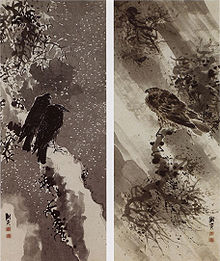Yosa Buson
Yosa Buson or Yosa no Buson ( Japanese 与 謝 蕪 村 ; * 1716 in Kema, Settsu Province , now municipality in Osaka ; † January 17, 1784 in Kyōto ) was a Japanese poet and painter of the Edo period . With Matsuo Bashō , Kobayashi Issa and Masaoka Shiki , he is one of the "Big Four" of Japanese haiku poetry. His real last name was Taniguchi. Part of his work (more than 200 haikus) was only discovered in 2015 in a hitherto forgotten anthology in Tenri's central library .
Life
Buson came to Edo (now Tōkyō ) around the age of 20 and learned poetry under the guidance of the haiku master Hayano Hajin . After his death he went to Shimo-Usa Province (now Ibaraki Prefecture ). Following the example of his idol Matsuo Bashō, Buson embarked on a journey through the wilderness of North Honshūs , which Bashō had inspired for his famous Oku no Hosomichi ( 奥 の 細 道 On remote paths into the hinterland ). First was his poet pseudonym Saicho . In 1744 he signed his first haiku and his travel notes for the first time under his own name.
After further extensive journeys through various parts of the country, including Tango Province (the northern part of what is now Kyoto Prefecture ) and Sanuki Province ( Kagawa Prefecture in Shikoku ), Buson settled in Kyoto at the age of 42 . It was around this time that he began writing under the name Yosa. Buson presumably derived this name from the birthplace of his mother (Yosa in Tango Province), but this has not been proven.
Buson married at the age of 45 and had a daughter, Kuno. Since then he has lived in Kyoto, wrote and taught at Ryokan Sumiya . In 1770 he took the name Yahantei II ( 夜半 亭 ). Yahantei was the stage name of his teacher Hajin. This was the beginning of his official career as a Haikai master. Buson achieved that the Haikai poetry regained the literary value of the Genroku period. He triggered a "back-to-Basho movement", the focus of which was the circle of poets he led.
Buson was also active in painting throughout his life and, along with Ike no Taiga, is one of the most important artists in the Nanga style. Buson died at the age of 68. His tomb is near the Kompuku-ji temple in Kyoto.
Haiku
| Japanese | transcription | translation |
|---|---|---|
|
菜 の 花 や |
na no hana ya |
Rapeseed blossoms! |
literature
- Buson: Poet's Landscapes. An anthology . Dieterich'sche Verlagsbuchhandlung, Mainz 1992, ISBN 3-87162-030-0 (translated from Japanese and provided with an introduction and annotations by Geza S. Dombrady).
- Cheryl A. Crowley: Haikai poet Yosa Buson and the Basho revival . Brill Publ., Leiden 2007, ISBN 978-90-04-15709-5 (Brills Japanese studies library; 27).
- Yukio Sawa: Haiku master Buson. Translations from the writings of Yosa Buson with related materials . White Pine Press, Buffalo, NY 2007, ISBN 978-1-893996-81-6 .
- Makoto Ueda: The path of flowering thorn. The life and poetry of Yosa Buson . University Press, Stanford, Calif. 1998, ISBN 0-8047-3042-3 .
Works in German translation
- Yosa Buson: The Hell King's Mouth . Edited by Elena Moreno Sobrino, German translation by A. Gerhard, illustrated by ElgA. Calambac Verlag, Saarbrücken 2017, ISBN 978-3-943117-936 .
Web links
- Literature by and about Yosa Buson in the catalog of the German National Library
Individual evidence
- ^ Encyclopædia Britannica: Buson
- ↑ KEIJI SATO: Hundreds of poems by haiku master Buson discovered. The Asahi Shimbun, October 15, 2015, archived from the original on October 16, 2015 ; accessed on October 17, 2015 .
| personal data | |
|---|---|
| SURNAME | Yosa, Buson |
| ALTERNATIVE NAMES | 与 謝 蕪 村 (Japanese); Yosa no Buson |
| BRIEF DESCRIPTION | Japanese poet and painter |
| DATE OF BIRTH | 1716 |
| PLACE OF BIRTH | Kema, Settsu Province , Osaka |
| DATE OF DEATH | January 17, 1784 |
| Place of death | Kyoto |

